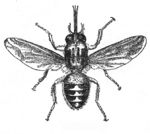Glossinidae
| Glossinidae spp. | |
|---|---|
| Kingdom | Animalia |
| Phylum | Arthropoda |
| Class | Insecta |
| Order | Diptera |
| Super-family | Hippoboscoidea |
| Family | Glossinidae |
| Genus | Glossina |
Also known as: TseTse flies
Introduction
The only genus in the family Glossinidae is Glossina, more commonly known as TseTse flies. They are solely found in sub-Sahara Africa, and feed on the blood of vertebrates.
Hosts
Various mammals, reptiles and birds.
Identification
TseTse flies are 6-13mm in length, and have long, prominent forward pointing proboscis. They have a green thorax, and a yellow/brown abdomen. The wings contain a very characteristic 'butchers cleaver' shape.
The larvae are a creamy white colour, and clearly segmented.
Life cycle
The females are viviparous, and only lay a single egg at a time. The fertilized eggs are held in the oviduct, where they hatch into larvae. The larvae develop, and when they are fully mature the larvae drop onto the ground.
The larvae then form pupae. This process takes several weeks, but can be considerably longer under cool conditions. The pupae transform into adults around one month later. The TseTse flies are blood feeders, and the females will require several good blood meals, before producing their first larva.
The complete life cycle of the Glossina takes 2 months.
| Glossinidae Learning Resources | |
|---|---|
 Search for recent publications via CAB Abstract (CABI log in required) |
Tse tse fly publications |
| This article has been peer reviewed but is awaiting expert review. If you would like to help with this, please see more information about expert reviewing. |
Error in widget FBRecommend: unable to write file /var/www/wikivet.net/extensions/Widgets/compiled_templates/wrt695e2f33b6e499_21906761 Error in widget google+: unable to write file /var/www/wikivet.net/extensions/Widgets/compiled_templates/wrt695e2f33c3cc08_60679027 Error in widget TwitterTweet: unable to write file /var/www/wikivet.net/extensions/Widgets/compiled_templates/wrt695e2f33cea7d2_05658034
|
| WikiVet® Introduction - Help WikiVet - Report a Problem |
